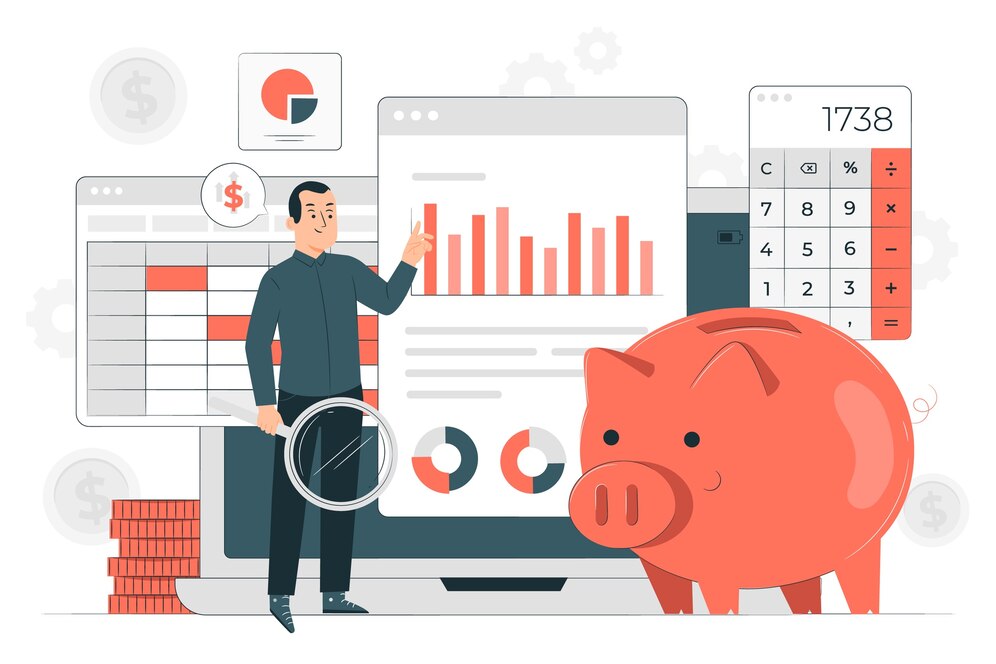In today’s fast-paced world, every dollar counts, especially for young adults who are just beginning their financial journey. Whether you’re fresh out of college, navigating early career challenges, or striving to establish financial independence, developing smart money saving strategies is essential. In this comprehensive guide, we’ll explore actionable tips, cutting-edge modern solutions, and financial planning techniques to empower you to save more, spend wisely, and build a secure future.
This article will provide a deep dive into:
-
Understanding your current financial landscape and the challenges posed by rising costs.
-
Analyzing everyday expenses critically to identify areas where you can cut back.
-
Modern solutions and digital tools that simplify budgeting and saving.
-
Ideas and strategies to improve your savings and build an emergency fund.
-
Step-by-step financial planning to ensure long-term success and stability.
With a natural flow and engaging tone, let’s explore how you can master your money and pave the way toward financial freedom.
- Understanding the Financial Landscape for Young Adults
- Analyzing Your Expenses: What to Cut and What to Keep
- Modern Solutions to Money Savings
- Ideas on How to Improve Your Savings
- Financial Planning: Laying the Groundwork for Long-Term Success
- Cutting-Edge Financial Tools and Modern Strategies
- Practical Steps to Implement Your Savings Strategy
- The Critical Analysis: What Prices to Cut and Why
- Integrating Financial Planning into Daily Life
- The Road Ahead: Long-Term Financial Freedom
- Final Thoughts: Crafting Your Path to Financial Success
- Summary of Key Strategies
Understanding the Financial Landscape for Young Adults
The Economic Reality Today
Young adults face an ever-changing economic environment where inflation, fluctuating prices, and a competitive job market shape everyday financial decisions. Whether it’s the soaring cost of housing in urban centers or the price hikes in everyday commodities, understanding these factors is the first step toward effective money management.
Recent economic trends indicate that many young professionals are experiencing what some call a “cost-of-living squeeze.” This means that even though incomes might be increasing, so are the expenses related to rent, transportation, groceries, and entertainment. In this environment, every small saving counts, and being proactive about money management can lead to substantial benefits over time.
Challenges in Financial Planning for Young Adults
Unlike previous generations that might have benefited from more stable economic periods, today’s young adults must deal with:
-
High rent and housing costs: Urban areas, where many job opportunities exist, often come with exorbitant rent prices.
-
Student debt: A significant portion of young adults graduate with debt that can hinder their ability to save.
-
Unpredictable job markets: With rapid changes in technology and industries, job stability can be a concern.
-
Rising cost of living: Daily expenses, from groceries to transportation, are consistently on the rise.
Understanding these challenges helps in creating realistic, attainable goals that align with your financial situation. It’s all about striking a balance between maintaining a decent quality of life now and ensuring future financial security.

Analyzing Your Expenses: What to Cut and What to Keep
Conducting a Financial Audit
Before you can save money, it’s crucial to understand where it’s going. Start with a detailed audit of your monthly expenses. Divide your spending into categories such as:
-
Housing: Rent, utilities, and insurance.
-
Transportation: Car payments, fuel, insurance, and public transport.
-
Food: Groceries, dining out, and takeout.
-
Entertainment: Subscriptions, hobbies, and leisure activities.
-
Debt Payments: Loans, credit card bills, and student debt.
This financial audit not only highlights your spending patterns but also reveals where you might be overspending.
Critical Analysis of Prices
A key element in saving money is a critical evaluation of the prices you pay. Ask yourself:
-
Are you getting the best deal? Compare prices across multiple retailers, whether shopping online or in person.
-
Do you really need that extra feature? Often, premium subscriptions or services come with features that are seldom used.
-
Can you negotiate or switch providers? Sometimes, simply asking for a discount or switching to a competitor can lead to significant savings.
For example, many young adults find themselves paying for multiple streaming services, gym memberships, or subscription boxes that add up quickly. Critically analyzing each expense and cutting back on non-essential services can free up money that could be better allocated towards savings or debt repayment.
What to Cut: Identifying the Unnecessary
-
Subscription Overload: With the rise of subscription-based services for everything from entertainment to meal kits, it’s easy to lose track of how much you’re spending monthly. Audit these subscriptions and cancel those you rarely use.
-
Dining Out: While grabbing a coffee or dinner with friends is enjoyable, frequent dining out can significantly strain your budget. Instead, learn to cook simple meals at home.
-
Impulse Buying: Online shopping and flash sales can be tempting. Establish a “cooling-off” period before making non-essential purchases.
-
Brand Loyalty: Often, generic brands offer similar quality at a fraction of the price. Switching to these alternatives can make a considerable difference.
-
Unnecessary Luxuries: This might include premium cable packages, high-end gym memberships, or even costly hobbies. Evaluate whether these expenditures truly add value to your life or if they can be minimized.
Modern Solutions to Money Savings
Embracing Digital Tools and Budgeting Apps
One of the biggest advancements in personal finance has been the availability of budgeting and money management apps. These digital tools help track your spending in real time, set budgets, and even offer insights on how to save more effectively.
-
Budgeting Apps: Applications like Mint, YNAB (You Need a Budget), and PocketGuard can help you visualize your spending, categorize your expenses, and set savings goals. They often sync with your bank accounts, making it easier to see where every dollar goes.
-
Investment Platforms: Apps such as Robinhood, Acorns, and Stash allow you to invest small amounts of money, making investing accessible even if you don’t have large sums to start with.
-
Expense Tracking: Digital tools like Expensify or even simple spreadsheet templates can help you monitor your expenditures daily. The more aware you are of your spending habits, the easier it is to curb unnecessary expenses.
The Role of Automation in Saving
Automation is another modern solution that can simplify the saving process. By automating your savings, you remove the need for constant manual transfers or decisions. Here’s how you can automate your savings:
-
Automatic Transfers: Set up your bank account to automatically transfer a predetermined amount into a savings or investment account every payday.
-
Round-Up Programs: Many banks now offer round-up programs where your purchases are rounded to the nearest dollar, and the difference is automatically transferred to your savings account.
-
Subscription Management Tools: Use services like Truebill or Trim to monitor your subscriptions and alert you if you’re paying for services you no longer need.
Automation reduces the temptation to spend extra money and ensures that you consistently save a portion of your income without even thinking about it.
Digital Coupons and Cashback Services
Leverage technology to save money on everyday purchases. Digital coupons and cashback services like Rakuten, Honey, and Ibotta offer rebates on online and in-store purchases. These platforms can help you recoup a percentage of your spending, effectively lowering your overall expenses. By integrating these services into your shopping habits, you can enjoy significant savings over time.

Ideas on How to Improve Your Savings
Set Clear Financial Goals
To boost your savings, it’s essential to have clear, measurable financial goals. Goals give you direction and a sense of purpose. Whether it’s saving for a down payment on a house, building an emergency fund, or planning for a dream vacation, clear objectives will keep you motivated. Start by defining both short-term (saving for a weekend getaway) and long-term goals (retirement savings) and break them down into manageable milestones.
Create a Personalized Budget
A well-crafted budget is the foundation of financial success. Here’s a step-by-step process to create a budget that works for you:
-
List Your Income: Start with all your income sources, including salary, freelance work, and any side hustles.
-
Categorize Your Expenses: Use your financial audit to categorize all monthly expenses.
-
Allocate Funds: Assign a specific amount to each category. Ensure you’re prioritizing essentials like housing, utilities, and food.
-
Set Savings Goals: Decide how much you want to save each month and treat it as a non-negotiable expense.
-
Review and Adjust: Regularly monitor your budget and adjust it based on changes in your income or expenses.
Building an Emergency Fund
An emergency fund is a financial safety net that provides peace of mind in case of unexpected expenses such as medical emergencies, car repairs, or job loss. Financial experts recommend setting aside three to six months’ worth of living expenses in an easily accessible account. While it might seem challenging to accumulate such a fund, start small and gradually increase your savings over time.
Explore Side Hustles and Additional Income Streams
Increasing your income is as important as cutting costs. Consider the following options to boost your earnings:
-
Freelancing: Platforms like Upwork and Fiverr offer opportunities to monetize your skills.
-
Part-Time Work: Even a few extra hours a week can add up to significant savings over time.
-
Passive Income: Consider investments that yield dividends or explore opportunities in the gig economy.
-
Monetize Hobbies: If you have a passion or hobby, consider turning it into a small business or side project. Whether it’s photography, writing, or crafting, there’s potential to generate extra income.
Adopting a Minimalist Lifestyle
Living with less can dramatically improve your savings rate. Embracing minimalism means prioritizing quality over quantity, reducing clutter, and making intentional purchases that add value to your life. Consider the following minimalist strategies:
-
Declutter Regularly: Sell or donate items you no longer need. This not only declutters your living space but can also provide a small influx of cash.
-
Mindful Spending: Before making a purchase, ask yourself if it aligns with your long-term financial goals.
-
Focus on Experiences, Not Things: Allocate your resources to experiences that enrich your life, such as travel or learning new skills, rather than accumulating material possessions.
Negotiation: A Key Savings Skill
Negotiation isn’t just for boardrooms—it can be a powerful tool in everyday life. Whether you’re dealing with service providers, negotiating a better rate on your rent, or haggling over the price of a used car, honing your negotiation skills can lead to significant savings. Research market rates, prepare your arguments, and don’t be afraid to walk away if the deal isn’t right.
Financial Planning: Laying the Groundwork for Long-Term Success
Step 1: Define Your Financial Vision
Start by outlining your long-term financial aspirations. Ask yourself:
-
Where do I want to be in five, ten, or twenty years?
-
What lifestyle do I aspire to?
-
How much money do I need to support that lifestyle?
Your vision should encompass both personal and professional goals. Perhaps you dream of traveling the world, starting a business, or buying a home. Once you have a clear vision, you can begin crafting a financial plan that aligns with these aspirations.
Step 2: Develop a Comprehensive Budget
Your budget is the blueprint for your financial future. As mentioned earlier, creating a detailed budget involves:
-
Tracking Income and Expenses: Maintain meticulous records of your monthly cash flows.
-
Allocating Funds: Prioritize essential expenses and savings.
-
Reviewing Regularly: Life changes, and so should your budget. Schedule regular reviews and adjust as needed.
Step 3: Establish and Grow Your Emergency Fund
An emergency fund is your first line of defense against unforeseen financial setbacks. Aim to save at least three to six months of living expenses, and keep this fund in an easily accessible account. Over time, consider gradually increasing this fund to provide an even stronger financial buffer.
Step 4: Tackle Debt Strategically
For many young adults, debt—especially student loans or credit card debt—can be a significant burden. Develop a strategy to pay off high-interest debt as quickly as possible. Consider the following approaches:
-
Debt Snowball Method: Focus on paying off the smallest debts first, which can build momentum.
-
Debt Avalanche Method: Prioritize paying off debts with the highest interest rates to minimize overall interest paid.
-
Refinancing Options: Look into consolidating or refinancing your loans to secure a lower interest rate.
Step 5: Invest in Your Future
Once you’ve established a stable financial foundation, it’s time to make your money work for you. Explore various investment options, including:
-
Retirement Accounts: Contribute to retirement accounts such as a 401(k) or IRA. Many employers offer matching contributions—don’t leave that money on the table.
-
Stock Market: Consider investing in index funds or ETFs, which provide diversified exposure to the market.
-
Real Estate: If feasible, real estate can be a robust long-term investment. However, be mindful of market conditions and ensure you’re prepared for the associated responsibilities.
-
Alternative Investments: For the more adventurous, peer-to-peer lending or crowdfunding real estate platforms can be intriguing options. Always do your research before diving into alternative investments.
Step 6: Monitor, Evaluate, and Adjust
Financial planning is an ongoing process. Set aside time periodically to review your progress. Are you meeting your savings goals? Has your financial situation changed? Adjust your plans accordingly. Utilizing digital tools and budgeting apps can simplify this process, providing real-time insights into your financial health.
Cutting-Edge Financial Tools and Modern Strategies
Leveraging Artificial Intelligence in Personal Finance
Artificial intelligence (AI) is revolutionizing personal finance. Many modern budgeting apps now incorporate AI to analyze your spending habits, forecast future expenses, and offer personalized savings recommendations. These tools can automatically identify patterns in your spending and even suggest alternative products or services that are more cost-effective. By harnessing AI, you can fine-tune your budget and save money more efficiently than ever before.
Sustainable Spending for a Better Future
Sustainability isn’t just a buzzword—it’s a financial strategy. Many young adults are choosing to invest in sustainable products and services, which, although sometimes more expensive upfront, often result in long-term savings. For example:
-
Energy-Efficient Appliances: Investing in energy-efficient appliances may reduce utility bills significantly over time.
-
Eco-Friendly Transportation: Choosing a bicycle or electric scooter over a car can save on fuel and maintenance costs.
-
Sustainable Clothing: Quality over quantity can lead to fewer but better purchases in the long run.
Embracing the Gig Economy
The gig economy offers a flexible way to supplement your income. Platforms like Uber, Lyft, DoorDash, and freelance marketplaces allow you to monetize your free time. Whether you’re supplementing your primary income or exploring a passion project, the gig economy provides an avenue to increase your savings without committing to a full-time side job.
Practical Steps to Implement Your Savings Strategy
Step-by-Step Guide to Daily Money Management
-
Start Your Day with a Financial Check-In:
Begin each day by reviewing your budget and setting a spending limit. This mindfulness will help you stay on track and avoid impulse purchases. -
Plan Your Meals:
Create a weekly meal plan that minimizes dining out and maximizes home-cooked meals. Not only does this save money, but it also contributes to healthier eating habits. -
Track Every Purchase:
Whether you use a mobile app or a simple notebook, tracking your expenditures helps you recognize spending patterns and identify areas for improvement. -
Evaluate Necessities vs. Luxuries:
Before making any purchase, ask yourself if it’s a necessity or a luxury. Over time, this habit will naturally curb impulse buying. -
Set Weekly and Monthly Goals:
Break down your financial objectives into weekly and monthly targets. Celebrate small victories along the way to keep yourself motivated.
Crafting a Personal Savings Challenge
Create a personal savings challenge to make the process fun and engaging. For example, try a 30-day no-spend challenge where you commit to spending only on essentials. Document your journey, track your progress, and share your experiences with friends or on social media. Challenges like these not only boost your savings but also build a community of like-minded individuals who are equally committed to smart financial management.
Reassessing and Reducing Utility Bills
Utility bills can be a significant drain on your finances. Consider taking the following measures:
-
Energy Audits: Conduct an energy audit at home to identify inefficiencies.
-
Smart Home Devices: Invest in smart thermostats and energy-efficient lighting.
-
Service Providers: Compare different providers and switch to more affordable options where possible.
Travel and Entertainment on a Budget
Young adults love to explore and have fun, but travel and entertainment don’t have to break the bank. Consider these strategies:
-
Travel Deals and Rewards: Use travel reward programs and apps that offer discounts or cashback on bookings.
-
Free or Low-Cost Entertainment: Explore local events, community activities, and free online experiences.
-
Group Discounts: Organize outings with friends and take advantage of group discounts wherever available.

The Critical Analysis: What Prices to Cut and Why
Dissecting the Cost of Everyday Services
When scrutinizing your monthly expenditures, it becomes clear that several recurring expenses have a disproportionate impact on your budget. Here’s a closer look at some of these expenses and how to manage them:
-
Streaming Services:
While having access to multiple streaming platforms might seem like a luxury, subscribing to several services can add up quickly. Evaluate your viewing habits—if you rarely use certain subscriptions, cancel them or share accounts with friends or family members. -
Gym Memberships:
Health is important, but expensive gym memberships aren’t always necessary. Consider home workouts or community centers that offer low-cost exercise programs. Many fitness apps provide guided workouts that cost a fraction of a gym membership fee. -
Mobile Phone Plans:
Evaluate your current mobile plan against alternatives. Often, competitors offer better deals with comparable service quality. Sometimes, switching providers or negotiating with your current provider can lead to significant savings. -
Dining Out and Takeout:
While convenient, ordering food frequently can quickly eat into your monthly budget. Cooking at home not only saves money but also allows you to prepare healthier meals. Consider meal prepping as a strategy to reduce food expenses.
What to Cut: Prioritizing Financial Health
When it comes to cutting costs, the focus should be on eliminating or reducing expenses that do not add significant value to your life. Here are some expense categories to critically evaluate:
-
Non-Essential Subscriptions:
Cancel any subscriptions that are rarely used. Instead, opt for free alternatives or share subscriptions among friends to split the cost. -
Impulse Purchases:
Implement a waiting period for non-essential purchases. This can help differentiate between a fleeting desire and a genuine need. -
Excessive Luxury Spending:
High-end brands and luxury experiences can be tempting, but they often come with a hefty price tag. Look for value in everyday purchases and consider second-hand options where appropriate. -
Unnecessary Financial Fees:
Regularly review your bank statements and credit card bills for hidden fees. Switch to fee-free banking options when possible, and ensure that you’re not paying for services you can easily avoid.
By critically analyzing your expenses and cutting costs that don’t serve your long-term goals, you’re not only saving money—you’re reallocating resources to build a stronger financial future.
Integrating Financial Planning into Daily Life
Establishing a Routine
A robust financial plan is most effective when integrated into your daily routine. Here’s how to make financial planning a habit:
-
Morning Routine:
Dedicate a few minutes each morning to review your spending and savings goals. This sets a positive tone for the day. -
Weekly Reviews:
Schedule a weekly session to analyze your expenses, review your budget, and adjust your spending plan as needed. -
Monthly Financial Meetings:
Treat your finances like any other important appointment. Review your bank statements, evaluate your investment performance, and plan for upcoming expenses.
Educational Resources
To stay informed and make the best decisions, invest time in financial education. Read blogs, listen to podcasts, or attend webinars that focus on money management. The more you know about the intricacies of personal finance, the better prepared you will be to make informed decisions.
Building a Support Network
Surround yourself with like-minded individuals who are also committed to financial wellness. Join online communities or local groups where you can share tips, successes, and challenges. Having a support network not only provides accountability but also offers new perspectives and strategies that you might not have considered on your own.
The Road Ahead: Long-Term Financial Freedom
Embracing Patience and Persistence
Achieving financial freedom is a marathon, not a sprint. It requires consistent effort, patience, and the willingness to adapt to changing circumstances. While the path may be challenging at times, remember that every small step forward is a victory in itself. Over time, these steps add up, resulting in a robust financial foundation that can weather any storm.
Celebrating Milestones
Recognize and celebrate your financial milestones. Whether it’s paying off a significant chunk of debt, reaching a savings goal, or simply sticking to your budget for a full year, each achievement is worth acknowledging. Celebrations not only reinforce positive behavior but also motivate you to keep pushing forward.
Future-Proofing Your Finances
As you progress in your financial journey, keep an eye on the horizon. Regularly update your financial plan to account for changes in income, life circumstances, and economic conditions. Future-proofing your finances means staying flexible and adapting your strategies to maintain your financial health over the long term.
Final Thoughts: Crafting Your Path to Financial Success
Money saving isn’t just about pinching pennies—it’s about making smart, informed choices that pave the way for a secure and fulfilling future. For young adults, the journey toward financial stability begins with understanding your financial landscape, analyzing your expenses critically, leveraging modern tools, and developing a comprehensive financial plan.
By setting clear goals, automating savings, and embracing digital tools, you can transform everyday spending into opportunities for growth. Remember that the small decisions you make today—whether it’s cutting a non-essential subscription or opting for a home-cooked meal over takeout—can have a profound impact on your long-term financial well-being.
The strategies discussed in this article are not one-size-fits-all. They require personalization and regular adjustments to fit your unique circumstances. The key is to stay proactive, informed, and committed to your financial journey. With determination, discipline, and the right tools, financial freedom is within your reach.
In the world of money management, knowledge truly is power. Armed with the insights and strategies outlined above, you’re better prepared to face the challenges of today’s economy. Now is the time to take charge of your finances—review your budget, reassess your spending habits, and commit to a plan that supports your dreams and aspirations.
Remember, the journey to financial freedom is ongoing. It’s a continuous process of learning, adapting, and growing. By integrating these money-saving strategies into your daily life, you’re not just saving money; you’re investing in a future where you can live comfortably, pursue your passions, and achieve lasting financial success.
Take the first step today. Review your financial habits, set a clear plan, and start implementing these strategies one by one. Your future self will thank you for the foresight and discipline you cultivate now. Embrace the journey of smart money management and watch as every saved dollar transforms into the foundation of a brighter, more secure future.
Summary of Key Strategies
-
Understand Your Finances:
Analyze your current spending and be mindful of the economic challenges facing young adults today. -
Conduct a Financial Audit:
Identify where your money goes by categorizing expenses and critically analyzing costs. -
Embrace Modern Tools:
Use digital budgeting apps, automation, and AI-driven insights to streamline your financial planning. -
Cut Unnecessary Expenses:
Evaluate subscriptions, dining out, impulse purchases, and luxury spending. Focus on value and necessity. -
Set Clear Goals and Budget Wisely:
Define both short-term and long-term financial goals. Create a budget that reflects your income and priorities. -
Build an Emergency Fund:
Save three to six months’ worth of expenses to cushion against unexpected setbacks. -
Increase Income Streams:
Consider side hustles, freelancing, and passive income to boost your overall savings. -
Stay Informed and Adaptable:
Continue learning about personal finance, adjust your plan as needed, and celebrate your progress.
By taking these actionable steps, you’re not only managing your money better—you’re setting the stage for a secure financial future filled with opportunities and peace of mind.
This comprehensive guide on money-saving strategies for young adults provides an in-depth exploration of practical tips and modern solutions. With a focus on critical analysis of current prices, actionable ideas for cutting unnecessary expenses, and a step-by-step financial plan, this article is designed to empower you to achieve financial success. Whether you’re just starting your financial journey or looking to refine your existing habits, these strategies will help you manage your money more effectively and work toward long-term stability.
Start today, and embrace a future where every dollar is a step toward financial freedom. Happy saving!
By following these smart money moves, you’re investing in not just your bank account, but your overall quality of life. Remember: each small saving compounds over time, building a future that’s both secure and rewarding.


